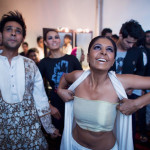Pakistaniaat : A Journal of Pakistan Studies Vol. 3, No. 3 (2011)
 Pakistan: Beyond the ‘Crisis State’
Pakistan: Beyond the ‘Crisis State’
Reviewed by David Waterman
Pakistan: Beyond the ‘Crisis State.’ Maleeha Lodhi, ed. London: Hurst and
Company, 2011. 391 pages. ISBN-13: 978-1-84904-135-5.
Maleeha Lodhi, as the editor of Pakistan: Beyond the ‘Crisis State,’ has managed
to assemble some of Pakistan’s most influential academics, writers, economists
and policymakers in one volume, designed to give an insider’s perspective on
Pakistan’s “crisis” from diverse angles, and more importantly, to suggest
solutions regarding Pakistan’s obvious potential for a better future. The book is
not a collection of conference proceedings, but rather the product of a virtual
conference in cyberspace, discussing themes of “governance, security, economic
and human development and foreign policy […] what binds all the distinguished
contributors is their belief that Pakistan’s challenges are surmountable and the
impetus for change and renewal can only come from within, through bold reforms
that are identified in the chapters that follow” (3).
 The first few chapters concentrate on Pakistan’s history and the sense of a
The first few chapters concentrate on Pakistan’s history and the sense of a
Pakistani identity, now that the country has existed in very concrete terms for
sixty-five years or so. Ayesha Jalal suggests that Pakistan’s path toward a
national identity for its heterogeneous people has been interrupted, as its history
has been co-opted for “political and ideological reasons” (11). Pakistan’s position
vis-à-vis India, militant Islam and 9/11 are all important factors in the equation as
well. Akbar Ahmed recalls Jinnah’s role not only in the founding of the nation,
but his continuing legacy in terms of an equilibrium between Islam and the State;
Jinnah’s thoughts are in large part gleaned from his speeches and letters, as he left
no monograph before his death (23). Mohsin Hamid, author of Moth Smoke and
The Reluctant Fundamentalist (filming for the movie has apparently begun),
assumes his mantle of engaged journalist in an essay entitled “Why Pakistan will
Survive.” His argument is best summed up as follows: “we are not as poor as we
like to think” (41), highlighting Pakistan’s strength in diversity, and in economic
terms, Hamid suggests that something as simple as a coherent, fair tax code could
allow the nation to concentrate on schools and healthcare, while cutting the
strings of American aid and its corresponding intervention in Pakistan’s affairs.
Maleeha Lodhi’s own chapter is a detailed overview of contemporary history,
calling attention to political asymmetry, clientelist politics and borrowed growth
David Waterman
as well as security concerns and regional pressures on national unity; ultimately
she calls for a “new politics that connects governance to public purpose” (78).
The essays then move into more political themes, and the first among them
discusses the army as a central element of Pakistani political, and indeed
corporate, life. Shuja Nawaz argues that while the army has historically been a
significant power broker, the generation of commanders from the Zia and
Musharraf eras is about to retire, thus promising the possibility of change,
including the realization that “counterinsurgency operations are 90 per cent
political and economic and only 10 per cent military” (93). Saeed Shafqat also
discusses the political role of the military, saying that while elections are of
course essential to democracy, more attention needs to be paid to the rule of law
and the incorporation of cultural pluralism (95), never forgetting the role of
various elites within the process; he suggests that the emergence of coalition
politics is a hopeful sign. Islam’s role in politics is the focus of Ziad Haider’s
essay, tracing its evolution from Jinnah’s comments through the Munir report,
Islamization under Zia and Talibanization to the “This is Not Us” movement
(129) and the hope that moderate Islam represents the future of Pakistan. A
chapter entitled “Battling Militancy,” by Zahid Hussain, continues the discussion,
tracing the development of jihadist politics given the situation in Afghanistan.
The focus then shifts to economic policy, beginning with Ishrat Husain’s
insistence that economic policies cannot remain sound without solid institutions
behind them; he cites the long-term nature of economic progress, while successive
governments seem interested only in short-term horizons (149-150). Meekal
Ahmed follows the Pakistani economy from the early sixties and periods of
relative health, through Ayub Khan’s era, also a time of economic stability, which
changes under Bhutto and his nationalization programs, and since then has gone
from crisis to crisis, both the government and poor IMF oversight bearing a share
of the blame. Competitiveness is the key concept for Muddassar Mazhar Malik,
who reminds us that Pakistan is “open for business” despite many challenges to
overcome, citing economic potential, natural resources and strategic location as
strong points (201). Ziad Alahdad then shifts the focus to energy, a sector in
crisis which then has an enormous impact on Pakistan’s economy, all of this in a
country with abundant natural energy resources; a more coherent exploitation of
Integrated Energy Planning would be part of an overall solution (240).
Strategic issues then occupy several chapters, beginning interestingly with
education as part of the formula, as advanced by Shanza Khan and Moeed Yusuf,
who suggest that politically-neutral education is the foundation not only of
Pakistaniaat : A Journal of Pakistan Studies Vol. 3, No. 3 (2011)
economic development but also the means to resist violent extremism by building
expectations and supplying hope, especially for the young. Pakistan of course
possesses nuclear weapons, and Feroz Hassan Khan asks the question, wondering
if its nuclear capability has allowed Pakistan to focus itself on other priorities, in
other words averting wars rather than fighting them, to paraphrase Bernard
Brodie, cited in Khan’s essay (268). Munir Akram’s essay, “Reversing Strategic
‘Shrinkage,’ highlights Pakistan’s current challenges: the Pakistani Taliban’s
attacks in KP and large cities; Pakistan’s involvement in Afghanistan; Balochi
alienation; economic stagnation; energy crises; growing poverty, all of which
have contributed to “a dangerous mood of national pessimism,” according to
Akram (284). Afghanistan occupies Ahmed Rashid’s attention, as it has for over
thirty years now; he critiques strategic claims that have become worn with time,
such as the need for strategic depth for Pakistan (although the notion of ‘strategic
depth’ changes when a country becomes a nuclear power), or India’s desire
(among other countries) to gain influence in Kabul (314-315). The final essay,
“The India Factor,” culminates the volume by tracing the tumultuous relations
between the two nuclear-armed neighbors, the bumpy road to peace, the effect of
the 2008 Mumbai attacks, all within the context of peoples who have not
forgotten the trauma of Partition and the secession of East Pakistan. In spite of
the obstacles, Syed Rifaat Hussain lists many of the promising agreements that
have been reached or are in progress, an encouraging sign and a reminder that
good relations are beneficial to both nations.
Human development, Maleeha Lodhi remarks in a concluding note, must
be Pakistan’s priority, and is within reach, as all of the contributors to the volume
insist. Lodhi summarizes thus: “Electoral and political reforms that foster greater
and more active participation by Pakistan’s growing educated middle class will
open up possibilities for the transformation of an increasingly dysfunctional,
patronage-dominated polity into one that is able to tap the resilience of the people
and meet their needs” (350). Pakistan: Beyond the ‘Crisis State’ is a fine piece
of work, written by specialists for an audience of intelligent non-specialists, and
achieves its objective admirably. Maleeha Lodhi has succeeded remarkably in her
edition of this gathering of clear-sighted experts, who never lose sight of
Pakistan’s potential beyond its current challenges.












THE REAL PAKISTAN
Posted by admin in BALOCHISTAN-A RAY OF HOPE FOR PAKISTAN, PAKISTAN ARTS & LITERATURE, PAKISTAN BRIGHT FUTURE, PAKISTAN STRONG, Pakistan's Beauty, Pakistan-A Nation of Hope, Pakistan-A Nation of Love & Romance, Pakistan-A Nation of Many Faiths, Pakistan-A Polaris of Earth, PAKISTAN-LAND OF ROMANTICS & DERVISH POETS, PAKISTANI POETRY, PAKISTANI SOLDIERS, PAKISTANI THINKERS & COMMENTATORS, PAKISTANI WATAN KAY MUHAFIZ, PAKISTANIS FACE DARKNESS BEFORE THE DAWN, PAKISTANIS LIGHT UP THE WORLD, PASHTUNS:THE IRON SHIELD OF PAKISTAN, Pathfinders of Islam on June 8th, 2014
http://amfunworld.blogspot.com/2011/02/10-reasons-why-i-still-love-pakistan.html
Please Visit These Great Pakistani Websites:
Articles Courtesy:
http://paksabka.com.pk/2014/03/10/be-pakistani-buy-pakistani/
http://amfunworld.blogspot.com/2011/02/10-reasons-why-i-still-love-pakistan.html
BE PAKISTANI, BUY PAKISTANI
Pakistan Has More Oil Reserves than Iran and Saudi Arabia
Nawaz Sharif ki English
Drunk Amir of Kuwait in welcome reception at Tehran
Load Shedding Funny Video
Funny Accident in Pakistani Wedding!
Proud to be Pakistani
Beautiful Pakistan
No Comments